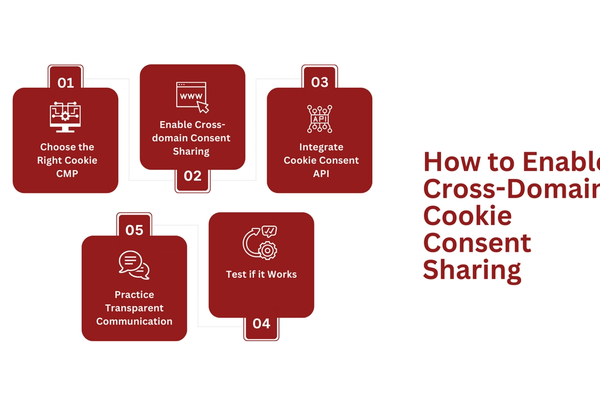
If you have a website with multiple domains or subdomains, you’re likely already familiar with cookies and cookie consent.
However, you may need clarification about what cross domain cookie consent entails and how to set it up on your website. If so, you’ve come to the right place!
This article will explore what cross domain cookie consent is, why it matters, and how you can implement it to create a secure and user-friendly browsing experience for your consumers.
Let’s dive right in.
Key Takeaways
Cross domain cookie consent lets users decide if their data can be shared between related websites.
Implementing cookie consent appropriately for multiple domains keeps you compliant with applicable data protection laws. In doing so, you avoid penalties and demonstrate your dedication to responsible data management.
Cross domain cookie consent sharing allows you to deliver a seamless user experience across your interconnected websites. Users who opt-in enjoy personalized content and smoother interactions, boosting overall satisfaction.
What is Cross Domain Cookie Consent?
What is Cross-Domain Cookie Consent.png

First things first, cookies are small pieces of data stored on a user’s device (e.g., phones and computers). They are often used to remember users’ preferences and track their online activities.
Cross domain cookie consent refers to the process of obtaining permission from your website visitors before sharing cookies across your related websites or domains.
Without this privacy tool, you could violate the cookie consent requirements of privacy laws like the General Data Protection Regulation (GDPR) and the California Privacy Rights Act (CPRA).
To put this in context, let’s say you run an online store with a central website for shopping and a separate subdomain for your blog. If a consumer agrees to the cookies on the shopping site but not on the blog, you could be in trouble if you use those blog cookies for marketing purposes without valid consent.
Is Cross Domain Cookie Consent Allowed?
In general, cross domain cookie consent is allowed if one of two scenarios occurs:
Your websites or domains have identical cookie types and settings
Users have given explicit consent to cookies across all your websites or domains.
However, if the cookie types or preferences differ between domains, especially if some domains use third-party cookies, cross domain cookie consent might not be allowed.
It all boils down to having consistent cookie setups and user consent across connected websites. Therefore, it’s important to ensure you understand your specific cookie practices and the requirements of applicable privacy laws to determine if cross domain cookie consent is permissible for your business.
Want a custom and effective cookie consent solution for your business? Get in touch for a free consultation.
How Cross Domain Cookie Consent Works
How Cross-Domain Cookie Consent Works.png

Picture this: you have several websites with multiple domains or subdomains, each using cookies to gather consumers’ personal information.
To provide a seamless user experience, you’ll likely need to share cookies between your websites to remember users’ preferences, login details, and other useful things.
Now, before sharing cookies across your domains, you need to respect your users’ privacy by obtaining their consent. The most common way to get this is through a cookie banner or pop-up that explains your cookie practices.
When a user visits your site and consents to cookies on one domain, that consent might not cover the cookies on the other domains. That’s where cross domain cookie consent comes in.
cross domain cookie consent allows you to obtain user consent once for all your domains through your cookie banner. This way, users don’t have to provide consent every time they visit your related websites or domains.
How to Enable Cross Domain Cookie Consent
Setting up cross domain cookie consent not only allows you to adhere to data privacy regulations but also enhances your users’ experience on your websites or domains.
Now, let’s go over the process step-by-step to ensure proper implementation.
Assessment and Identification
Start by identifying the websites or domains connected to your business. These could be different sections of your main website, microsites, partner websites, or related platforms.
Whichever the case, you need to understand the purpose of sharing cookies across these domains.
Cookie Inventory
Next, you need to take stock of the types of cookies used across your websites or domains. Categorize them based on their functionality to help you communicate their purposes clearly to your users.
Practically speaking, most cookies fall into one or more of the following categories:
First-Party Cookies
Third-Party Cookies
Session Cookies
Persistent Cookies
Strictly Necessary Cookies
Performance Cookies
Functionality Cookies
Targeting or Advertising Cookies
Consent Mechanism Setup
After taking stock of your cookies, the next step is to implement a user-friendly cookie consent mechanism that informs users about your cross domain cookie practices.
The most common mechanisms used across websites include:
Cookie consent banners
Cookie pop-ups
Integrations into the website design
Regardless of your chosen method, you’ll need to clearly explain why you’re sharing cookies across domains, what data will be shared, and the benefits users will receive.
Transparent Explanations
It’s important to use simple language to explain your cookie-sharing process.
Inform users that by allowing cross domain cookie sharing, they’ll enjoy a more seamless experience across your platforms. Also, highlight their right to decline without facing any negative consequences.
Opt-In and Opt-Out Options
When presented with your cross domain cookie practices, consumers can either accept your terms (opt-in) or reject them (opt-out).
In any case, you must ensure that your consent mechanism offers an easy way to agree and a straightforward way to decline. If users decline, respect their decision and don’t share their data across your domains.
Granular Controls
If possible, provide users with granular controls over the types of cookies they’re comfortable with sharing across domains. This gives them a sense of customization and control over their online experience.
User Education
Consumers have the right to know your cookie usage practices and must provide this information in explicit detail. Accordingly, you must maintain a simple and accessible privacy policy that explains cross domain cookie consent and link to this policy wherever you seek user consent.
Alternatively, you can provide comprehensive details about your cookie practices on a separate webpage in a cookie policy.
Technical Implementation
Now it’s time to activate your cross domain cookie consent mechanism. You’ll need to work with your web development team to make sure the technical implementation of your cross domain cookie consent is seamless and error-free.
Testing and Feedback
Before rolling out the consent mechanism to your users, conduct thorough testing to ensure it works across different devices and browsers. Collect feedback from various users to identify any potential issues.
Regular Review
Finally, you need to keep your consent mechanism and cookie-sharing practices under regular review. If there are changes in your websites or regulations, update your explanations accordingly.
Need help with enabling cross domain cookie consent? Captain Compliance has your back. Get in touch for a free consultation today.
How to Enable Cross Domain Cookie Consent Sharing
How to Enable Cross-Domain Cookie Consent Sharing.png

When cookies are shared between different websites or domains owned by the same company or connected partners, it’s called cross domain cookie sharing.
Enabling cross domain cookie consent sharing helps you create a smooth and cohesive experience for your users while respecting their data privacy rights.
Here’s how to do it:
Choose a Cookie CMP That Supports Cross Domain Consent Sharing
There are many Consent Management Platforms (CMPs) on the market, so it’s important to do your research and select one that fits your business needs.
Also, ensure the CMP you choose supports cross domain consent sharing so that you can collect user consent across multiple domains. A powerful compliance solution you can employ here to help you out with a custom platform is Captain Compliance.
Configure Your CMP to Enable Cross Domain Consent Sharing
Once you’ve chosen a CMP, you’ll need to configure it to allow cross domain consent sharing. This usually involves adding a few lines of code to your website’s code.
Integrate Cookie Consent API
Next, you need to integrate the CMP’s Application Programming Interface (API) into all your domains. This step ensures that when a user provides or withdraws consent on one domain, the information is immediately shared with other domains.
Test Your cross domain Consent Sharing Implementation
Regardless of which domain users interact with first, their cookie consent preferences must remain consistent across the various domains under your control. So, after configuring your CMP to enable cross domain consent sharing, you’ll need to test it to ensure it works correctly.
You can do this by visiting your website from different domains to make sure your cookie banner is displayed correctly, and users’ consent is shared across your domains.
Practice Transparent Communication
Again, it’s important to be as transparent as possible when describing your cookie practices. Let users know that their cookie preferences will be shared across your domains to enhance their browsing experience while maintaining their privacy choices.
How Can Captain Compliance Help?
Need help ensuring your business is completely compliant with all your future compliance endeavors, including enabling cross domain cookie consent? Captain Compliance has got you covered.
Our cookie compliance services ensure that your website gets user consent seamlessly. We’ll help you set up adequate consent mechanisms, update privacy policies, and tailor your approach to match your specific business needs.
Get in touch today for a 100% free consultation for your business needs!
FAQs
Why should my business bother with cross domain cookie consent?
It’s about respecting users’ privacy and the requirements of data protection laws. Implementing cross domain cookie consent ensures you follow regulations while delivering a seamless user experience across all your websites and domains.
Find out how to implement cookie consent on your website
How do I set up cross domain cookie consent on my websites?
Start by assessing your cookies across domains to ensure cross domain cookie consent is permissible for your business. After that, you need to set up your consent mechanism, including clear options for users to either agree or decline to share data across your related domains.
Learn about cookie consent best practices here
Can users opt for cross domain consent on one site but not others?
Absolutely. If your consent mechanism offers granular options, users can choose which websites or domains they’re comfortable sharing their cookie data with.
Find out our best cookie consent solutions
What if users decline cross domain cookie sharing?
Respect their choice. If your users decline your cross domain cookie-sharing practices, ensure their data isn’t shared between your domains. Moreover, their experience on your sites shouldn’t be affected.
Find out what happens if you don’t comply with the GDPR’s cookie consent